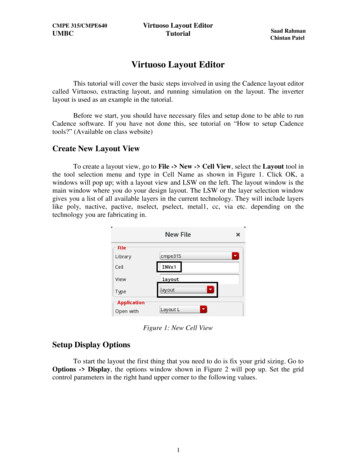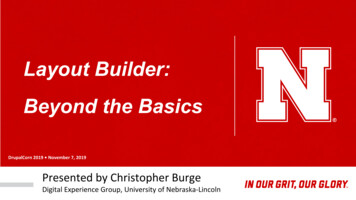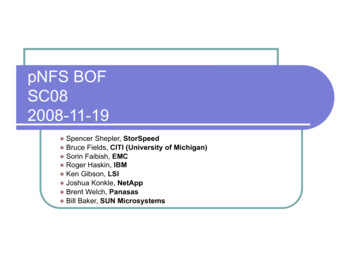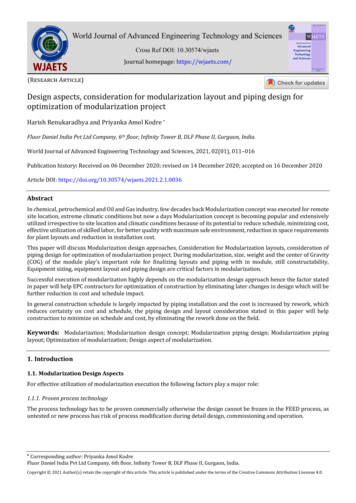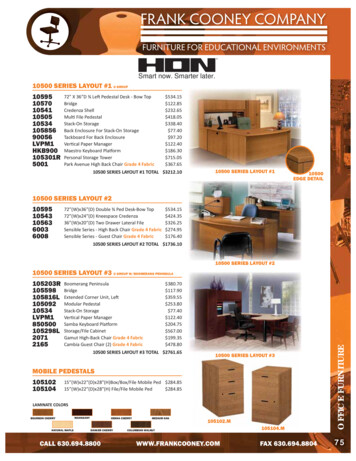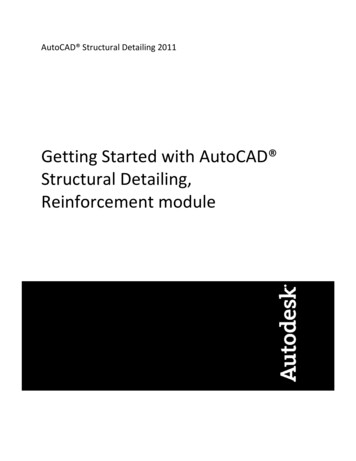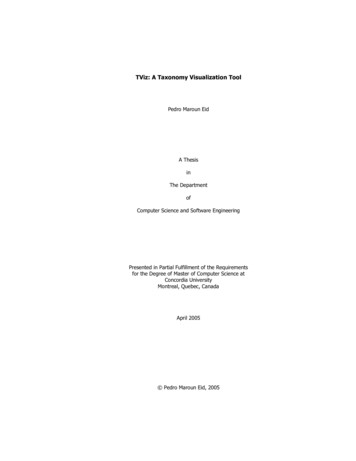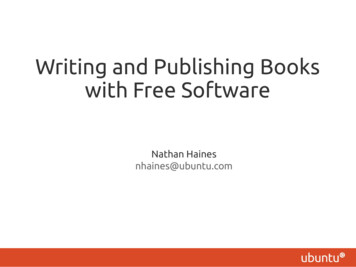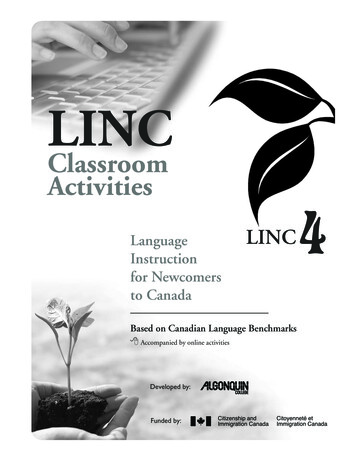
Transcription
LINCClassroomActivitiesLanguageInstructionfor Newcomersto CanadaLINCBased on Canadian Language Benchmarks8 Accompanied by online activitiesDeveloped by:Funded by:4
ACKNOWLEDGEMENTSPrincipal WritersKathleen JohnsonShelia MorrisonContributing WriterJoyce LaxE-learning DeveloperJim EdgarPrincipal EditorsKathleen JohnsonCopy EditorHelen BachCanadian LanguageBenchmarks EditorRon LavoieAudio ProductionNew Media Language Training Inc.(Rob McBride; David Bignell; Christine Doyle)Graphic DesignDesign Ink of Algonquin College(Karen Young; Graham Ross; Beth Haliburton)Project CoordinatorMavis SpencerShelia MorrisonThe project team would like to thank Sheila McMullin, Nicole Busby and Heather Richmond for their supportthroughout; Citizenship and Immigration Canada for funding this project; and the following individuals for theirgenerous contribution of time and expertise:Advisory CommitteeSalome AtandiMyra ClarkShirley GrahamRon LavoieAdonai RodriguezNicole BusbyJim EdgarAnne-Marie KaskensRob McBrideRuth WatersExpert ReadersCynthia ClubbSusan MiddlesworthLarry IvesonNorbert MolzanExpert Reader: E-resources Susan MiddlesworthCopyright Algonquin College 2009Published by The Print ShopCreative design by Design Ink of Algonquin College 2009All rights reserved.ISBN 978-1-55323-512-5
NOTES TO READERSNotes to Readers This book is a miscellany of language learning activities organized by the twelve themes in theLINC 1-5 Curriculum Guidelines. It is intended as a supplementary resource of self-contained andreproducible activities to complement existing LINC programming. The attached CD ROM containsthe book in PDF format. The choice and development of activities was determined by a wide range of factors, including: the LINC 1-5 Curriculum Guidelines;a survey of needs of LINC instructors in Ontario;the requirement to adhere to the appropriate Canadian Language Benchmarks;the classroom experience of the writers;a mandate to address the specific needs of women, youth (school-leaving age to twenty-nineyears old) and seniors, as identified in the Consultations on the Settlement and Language TrainingServices Needs of Newcomers in Support of the Canada-Ontario Immigration Agreement, 2006. Every activity has been assessed by a CLB-trained editor to ensure alignment with the appropriatebenchmarks. A general methodology is provided for each activity, but it is anticipated that instructors will makemodifications based on the needs of their particular classes. The book contains a wide range of tasks that can be used as assessment tools. They adhere to theCompetency Outcomes outlined in the Canadian Language Benchmarks. The activities target the following benchmark levels:LINC 1LINC 2LINC 3LINC 4SpeakingCLB 1CLB 2CLB 3,4CLB 5ListeningCLB 1CLB 2CLB 3,4CLB 5ReadingCLB 1CLB 2CLB 3CLB 4WritingCLB 1CLB 2CLB 3CLB 4About the e-ResourcesWhat is the purpose of the e-resources?The purpose of the e-resources is to both stimulate and challenge learners using web-based multimediatechnologies. Good teaching practice necessitates the use of a variety of learning activities, and theseresources give teachers another mode of delivery to enhance learning.Continued on next page.Language Instruction for Newcomers to CanadaI
NOTES TO READERSWho are the e-resources for?These e-resources are appropriate for use by students working independently outside of a LINC class orinside a computer lab facilitated by a classroom instructor. In fact, the e-resources are ideal for use in acomputer lab; each learning object has a lead-in page to introduce the background language and anyrequisite knowledge.What is the best way to introduce students to an e-activity?As with any learning activity, the e-activities will be more meaningful and students will have a greater chanceof success if they are introduced to the task.The lead-in page for each activity addresses this by providingsuggested discussion questions and a link to a related website, which can extend these discussions.Theseintroductory activities are optional; instructors may use their own introduction or they may use the activitiesin the print version as the lead-in to the e-activities.This lead-in page also has links to the e-activities, and a linkto a password-secured answer key.The password is “lincesl”.Are the online activities the same as the paper-based activities?While some of these e-activities are very similar to the paper-based activities, many are different. Instructorsshould check before using both the print- and e-activities.What is the role of the teacher using these e-activities?Instructors using this book are encouraged to incorporate the e-activities into their lesson planning using abalanced approach. Generally, with the exception of the communication during the introduction, there is nocollaboration in these self-study activities. In addition, because of the limitations of technology in providingfeedback on written work, there is little opportunity for students to write, other than completing clozeexercises, correcting errors in texts, and filling in short answer type questions. Instructors should ensurelearners have a balanced opportunity to practice all of the language skills, especially writing and speaking.What is the password for the instructor’s answer key on the introduction pages?The password is “lincesl”. Do not give learners the password.They do not need the answer key because allof the activities are self-correcting.Why do I need an answer key if the e-activities are self-correcting?The purpose of the answer key is to help instructors who are facilitating in a computer lab.The answer keyis to assist them make more effective use of their time when they are helping students at work stations.What are the technical requirements for using these resources?The e-activities have been tested with the following specifications: broadband Internet access Windows XP or later; or Mac OS X (v. 10.5) Browsers:Windows: Firefox 3.5.5/ Macintosh: Safari 4.0.3 Screen resolution: 1024 X 768 (or higher) QuickTime Player plug-in (version 7 or higher) Adobe Flash PlayerIILanguage Instruction for Newcomers to Canada
CONTENTSLINC 4 ContentsWOMENYOUTHSENIORONLINETHEMES & ACTIVITIESAT HOME IN OUR COMMUNITY & THE WORLDDavid Suzuki: Environmental Hero . 3Good Things Come In Recycled Packaging . 7Community Recycling Programs . 11Enviro News . 14How Big Is Your Footprint? . 17Personal Acts Of Green . 20Earth Friendly Challenge . 22The Kobar Family I: Relocating . 27The Kobar Family II: The Spacious Semi-Detached . 31The Kobar Family III: A Great New Place To Live . 35BANKING, CUSTOMER SERVICE & TELEPHONEAll Our Lines Are Currently Busy . 41Gimme A Ring . 45What’s The Message? . 52Cell Phone Manners . 56Stop Bugging Me! . 59National Do Not Call List: FAQs . 64National Do Not Call List: Filing A Complaint On The Internet . 67Pre-Authorized Payment Plan Application Form . 70Monthly Budgets . 74Language Instruction for Newcomers to CanadaIII
CONTENTSCANADALibrary of Parliament . 85The Amazing Rattenbury Story: Part One . 95The Amazing Rattenbury Story: Part Two . 101The Amazing Rattenbury Story: Part Three . 110The Amazing Rattenbury Story: Part Four . 115The Amazing Rattenbury Story: Extensions For Group Discussions . 120Canadian Trivia: Question Formation Review . 125Did You Say Saskatchewan? . 134CANADIAN CULTURELovely Winter . 141Would You Like To Come Over? . 146I Like Your Dress! Giving And Receiving Compliments I . 161I Like Your Dress! Giving And Receiving Compliments II . 170Canadian Icons . 173The Greatest Canadian Hero . 186CANADIAN LAWLegal Vocabulary . 197The Cigar Story . 204The Spanking Case . 209Drinking And Driving . 221The CopShop Event . 231Personal Safety Test . 240Who Killed Mr. Green? . 245IVLanguage Instruction for Newcomers to Canada
CONTENTSCOMMERCIAL SERVICES & BUSINESSProduct Nutritional Information . 251It Tastes Good . 260Internet Use Survey . 265Shop Online . 271Internet Shopping Role Play . 276Gifts Online . 280Internet Shopping Cards . 284The Electronic Grandmother . 292COMMUNITY & GOVERNMENT SERVICESVolunteer Applications . 297Volunteer Experiences . 307Volunteer Ottawa . 3162-1-1 Community Services Information . 3242-1-1 Quick Facts . 3342-1-1 Role Play . 341Hey Dude . 345EDUCATIONJason’s Email. 351Parent-Teacher Interviews . 356Here Is My Opinion . 361Coping Strategies: My Experience . 366Family Coping Strategies . 368How Would You Like to Volunteer? . 374Learning Styles: Which Kind of Learner Are You? . 379Language Instruction for Newcomers to CanadaV
CONTENTSEMPLOYMENTCanadian Employers: What Do They Expect? . 385Vet Clinic Interview . 390Follow-up Letter: Central Veterinary Clinic . 395Mock Interview . 398Volunteer Heroes . 401Be Positive I . 407Be Positive II . 412FAMILY & RELATIONSHIPSFamily Conflict: The Sleepover Party I . 419Family Conflict: The Sleepover Party II . 423Family Conflict: The Sleepover Party III . 430Childfree By Choice I . 434Childfree By Choice II . 439It’s Our Choice . 442If I Were In Your Shoes . 446HEALTH & SAFETYCanadian Superfoods . 461Steps For Buying And Freezing Blueberries . 465Cranberries, A North American Superfruit . 468How To Prepare A Healthy Snack . 475Nutrition Tables . 478Food And Health Myths . 487VILanguage Instruction for Newcomers to Canada
CONTENTSTRAVEL & TRANSPORTATIONGetting Around Town . 495Alternative Transportation . 498Letter To The Editor . 502Confederation Bridge . 507A Perfect Day . 510Dream Destination . 513A Great Holiday . 515Travel Accommodations Canada . 518Travelling Experiences . 522Safety In Your City . 528Language Instruction for Newcomers to CanadaVII
LINCAt Home InOur Communityand The WorldBased on Canadian Language Benchmarks4
AT HOME IN OUR COMMUNITY & THE WORLDActivity:David Suzuki: Environmental HeroINSTRUCTOR NOTESAreading passage about the environmentalist David Suzukiis followed by comprehension questions.Timing: 45 minutesWARM-UP Begin with a class discussion on what it means to be a hero. Ask learners who their heroes were at various stages of their lives. Ask if anyone has heard of David Suzuki and make an outline on the board of theinformation they have.ACTIVITY Give each learner a copy of the reading David Suzuki: Environmental Hero. Learners read the text and answer the questions.FOLLOW-UP Learners search online for videos about David Suzuki.ANSWER KEY 1. He taught David to think about nature and the environment.2. He researched the life of fruit flies.3. answers will vary4. answers will vary5. answers will varyFURTHERREFERENCE See LINC Curriculum Guidelines, pp. 166-171.VOCABULARY environment; environmentalist; hero; scientist; host; broadcast; broadcaster; activist;Order of Canada; Companion of the Order of Canada; biology; zoology; genetics;cause (n.); to make sense; sibling; complexLanguage Instruction for Newcomers to Canada3
AT HOME IN OUR COMMUNITY & THE WORLDActivity:David Suzuki: Environmental HeroJoshua SherurcjiDavid Suzuki is an environmental hero. He loves the planet and he has worked for most of his life toteach us how to take care of it.David Suzuki was born in Vancouver, British Columbia in 1936. He has a twin sister and two other siblings.When David was growing up, he and his father Kaoru Carr Suzuki often went on fishing and camping tripstogether. David says his father is his hero because he taught David to think about nature and theenvironment.David Suzuki is a scientist. He studied in Canada and the United States and has a PhD in zoology. Hebecame very interested in genetics and researched the life of fruit flies. He taught biology, zoology andgenetics for many years in universities in Canada and the United States. Suzuki believes it is important tobe able to explain science very clearly.1. Why does David Suzuki say his father is his hero?4Level 4 R W
AT HOME IN OUR COMMUNITY & THE WORLDActivity: David Suzuki: Environmental HeroDavid Suzuki has spent his life trying to focus attention onto our planet and what we can do to improveit. He is very passionate about the world we live in and he gets excited when he talks about ways we canmake our lives healthier. He has written over thirty books, received over ten honorary degrees, andhosted television and radio programs. In 1991, he and his wife set up The David Suzuki Foundation to helpfind ways for society to live in balance with the natural world.2. A scientist is a person with an expert knowledge of science. What has David Suzukiresearched?One very special thing about him is that he is able to talk about complex issues in a way that is very easyfor most people to understand. David’s father practiced public speaking with him in the basement of theirhome when he was a small boy. David said his father wanted him to be an expert public speaker and agreat dancer. We don’t know very much about his dancing skills, but we do know that people around theworld love to hear him speak so passionately about the planet.3. An activist is a person who works very hard for a certain cause or reason. In your ownwords, explain why David Suzuki is an activist.Language Instruction for Newcomers to Canada5
AT HOME IN OUR COMMUNITY & THE WORLDActivity: David Suzuki: Environmental HeroNot everyone agrees with Suzuki’s ideas. Sometimes politicians and world leaders think he doesn’t makesense. Sometimes he says things that make them angry, but he doesn’t stop. In fact, his life and work havebeen recognized by the Government of Canada. In 2006, he received an award called The Companion ofthe Order of Canada for his efforts to teach us how to take care of our greatest resource, planet Earth.4. Think about what you could do to help the planet or just to help one person. If you gotan award for doing something to help others, what would the award be for?6Level 4 R W
AT HOME IN OUR COMMUNITY & THE WORLDActivity:Good Things Come In Recycled PackagingINSTRUCTOR NOTESLearners write emails to companies, telling them why they love their products, and how they thinkthe companies could make environmentally friendly changes to the product packaging.Timing: 15-20 minutes per emailWARM-UP Bring several product packages into the class and show learners the labelingcontaining the manufacturer contact information. Ask learners if they have ever written or telephoned a company to ask about aproduct. Ask why they have done this.ACTIVITY Distribute the handouts. Focus attention on the title and isolate the word‘recycled’. Explain its verb and adjective forms. Allow time for students to complete the exercises.FOLLOW-UP Have learners select one product from home that they have purchased and bringthe empty packaging into the classroom. read the recycling information find out if the materials are completely or partially recyclableFURTHERREFERENCE See LINC Curriculum Guidelines, pp. 166-171.VOCABULARY recycle(d) (v.); recyclable (adj.); recycled (adj.); package (v.); packaging (n.);fibre; leftover(s); spout; cartridge; valueLanguage Instruction for Newcomers to Canada7
AT HOME IN OUR COMMUNITY & THE WORLDActivity:Good Things Come In Recycled PackagingIn Canada, we can find a wide variety of packaged items for sale. Some of these items are sold in packagesthat contain 100% recycled products. Many others are not.1. Read these email samples. They were written to companies that do not use packaging materials thatcan be completely recycled. The people who wrote the emails believe that companies should try todo a better job of using recyclable materials.8Level 4 R W
AT HOME IN OUR COMMUNITY & THE WORLDActivity: Good Things Come In Recycled Packaging2. Study these word forms:WORDSENTENCErecycle (v.)Samir can think of a way to recycle almost anything.recycledHe recycled products before most of us thought about doing it.recyclable (adj.)Samir reads the labels on all products to see if they containrecyclable materials.package (v.)Samir is going to package his leftover dinner for lunch tomorrow.packagedSamir packaged the leftovers for his lunch.packaging (n.)The packaging was made from 100% recycled paper.Now write your own sentences containing these words.recycled (v.)recyclable (adj.)package (v.)packaging (n.)Language Instruction for Newcomers to Canada9
AT HOME IN OUR COMMUNITY & THE WORLDActivity: Good Things Come In Recycled Packaging3. Read the headings on the chart: PRODUCTWHY I LOVE ITPROBLEMUse the information to write your own email. Your instructor will tell you how many to write. Follow theexamples you have already read. 10name the producttell the company why you love their producttell them what you would like them to changePRODUCTWHY I LOVE ITPROBLEMAll-Ways GoodCereal fun shapes my children love it lots of fibre and low fatno recyclable materials inthe boxTop BananaFrozen Fruit Bars 100% fruit in every bar healthy product recyclable plastic stickpackage can be recycled,but bars are on anon-recyclable plastic stickSuper CleanLaundry Detergent great to use in cold water good valuebox is recyclable, but has ametal spout that is notColor MarkPrint Cartridge excellent black and whitecopies excellent color copiespackage is almost twice aslarge as the cartridge, so itis wastefulLevel 4 R W
AT HOME IN OUR COMMUNITY & THE WORLDActivity:Community Recycling ProgramsINSTRUCTOR NOTESLearners fill in a chart describing the recycling program in their communities.Timing: variesWARM-UP Ask learners if they have participated in a community recycling program in theirhome countries. Encourage learners to share information about these community recyclingprograms, for example: Where is waste collected? at the curb? in a common area for rental units? Who collects it? How often is it collected? weekly? bi-weekly? Is there a fee for pickup? What is included in the pickup? paper one week? plastics one week?ACTIVITY Give each learner the two-page handout. Review the information sheet and have learners write sentences to practice thevocabulary. Review the fact sheet and be sure learners understand what is required. Learners fill in the fact sheet with information about their community recyclingprograms.FOLLOW UP Learners search another city on the Internet and fill in the chart to compare.Discuss findings.ASSESSMENT Instructors correct individual fact sheets. CLB Performance Indicators: describe a situation: reader can follow uses simple structures; few errors uses adequate vocabulary for the topic spells correctly; follows punctuation conventions has legible handwriting or printingFURTHERREFERENCE See LINC Curriculum Guidelines, pp. 166-171.VOCABULARY recycle; recyclables (n.); waste; cart; collection; curb; depend onLanguage Instruction for Newcomers to Canada11
AT HOME IN OUR COMMUNITY & THE WORLDActivity:Community Recycling ProgramsDo you live in Northern Canada? Is your home in the Maritimes? Maybe you live in the middle of thecountry. Perhaps you wake up to the sound of the ocean, or to the sight of mountains or a field of wheat.Canada is a big country and we do many things differently depending on where we live.Many Canadians participate in recycling programs. The recycling program in the town of Yellowknife isdifferent from the one in the city of Winnipeg. The recycling program in the city of Montreal is differentfrom the one in the town of Sackville. What kind of recycling program does your community have?1. Write your own sentence to practice the vocabulary below. You will see these words in the chart onthe next page.recyclables (n.) materials that can be used again for another purposeNewspapers and glass bottles are recyclables.Your sentence:waste (n.) materials that cannot be recycledThrow this broken lamp and other waste into the garbage can.Your sentence:12Level 4 R W
AT HOME IN OUR COMMUNITY & THE WORLDActivity: Community Waste And Recycling Programs2. Read the form and fill in information about your community.Name of yourcommunityHow often is wastecollected?City, TownProvinceHow often are recyclablescollected?What are the specific hoursgarbage can be taken to the curb?How are waste and recyclables sorted? Is there a box, cart, or bag for plastics? For paper? For waste?How are containers for waste and recyclables identified? Is there a blue, black, or green box?Are recyclables sorted by the homeowner orby the recycling company?Are there pickups for special collections suchas Christmas trees, leaf or yard waste?Are there any programs for residents to put out good used items that neighbours can take awayfor free?Language Instruction for Newcomers to Canada13
AT HOME IN OUR COMMUNITY & THE WORLDActivity:Enviro NewsINSTRUCTOR NOTESAreading of a community newsletter is followed bycomprehension questions.Timing: 40 – 50 minutesWARM-UP Ask learners if the communities in their countries of origin circulate newsletters.If so, ask: what information may be found in them how the newsletter is distributed Ask learners if their communities in Canada circulate newsletters.ACTIVITY Distribute the Enviro News to each learner. Talk about the title and layout. Learners answer the questions on the Enviro News Fact Sheet, using dictionariesas required. Short answers are acceptable.ANSWER KEY 1. I Can Reuse That2. craft projects4. call 613-555-12345. composting7. contact person for Enviro News9. drearth@cyberspace.com3. online at green@magma.ca6. bring garbage bags and gloves8. something to grill10. 22ASSESSMENT Instructors correct individual learner fact sheets. CLB Performance Indicators: identifies layout of forms; finds specific information gets overall meaning; identifies type and purpose of text gets key information and specific details from verbal text uses simple structures uses adequate vocabulary for topicFURTHERREFERENCE See LINC Curriculum Guidelines, pp. 166-171.VOCABULARY compost (n., v.); dummies; seminar; depot; ‘green’ ideas; parkway; grill (v.); exchange14Level 4 R W
AT HOME IN OUR COMMUNITY & THE WORLDActivity:Enviro NewsVOL. 22SAT. JULY 4thBBQClean-Up Day at OttawaRiver ParkwaySat. 12:00Come and help us cleanEastboro Parkup the river parkwaySat., July 11thBring something9–to grill.12:00Drinksprovided.BringgarbageThank you tobagseveryone whoandparticipated in thegloves.neighbourhood“I CAN REUSETHAT”IT’S EASYBEING GREENgarage sale.Do you have a“green” idea thatyou’d like to share?Join theconversationonline atgreen@magma.caWANTED FORCRAFT PROJECTSpaper towel rolls, toilet tissue rolls, gift wraprolls, poster tubes.East Gate Elementary SchoolCall 613-555-8888 Sarah or MohammadCompostingQuest
the book in PDF format. The choice and development of activities was determined by a wide range of factors, including: the LINC 1-5 Curriculum Guidelines; a survey of needs of LINC instructors in Ontario; the requirement to adhere to the appropriate Canadian Language Benchmarks; the classroom experience of the writers;

